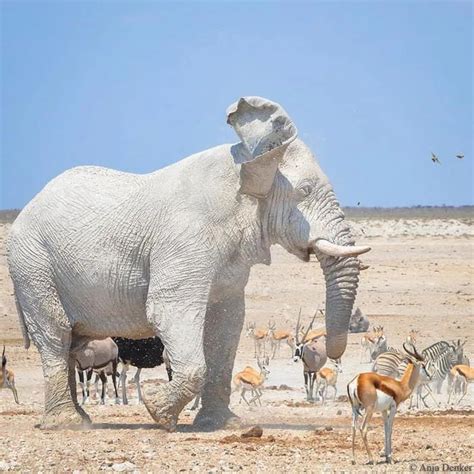
A rare, light-skinned elephant, nicknamed the “Ghost Elephant,” has been sighted in Botswana’s Okavango Delta, ending a five-year period during which its whereabouts were unknown. The unique animal, distinguished by its unusually pale pigmentation, was recently captured on film, confirming its continued survival and presence in the region.
The reappearance of the “Ghost Elephant” has generated excitement among conservationists and wildlife enthusiasts, who have long been fascinated by the animal’s unusual appearance and resilience. Its extended absence had fueled concerns about its well-being, prompting widespread interest in its fate. The recent sighting, therefore, serves as a reassuring sign for the elephant’s survival and the overall health of the Okavango Delta’s elephant population.
The elephant’s albinism or leucism, conditions resulting in reduced pigmentation, make it stand out dramatically against the backdrop of the African savanna. These conditions, while rare, are known to occur in various animal species, including elephants. In the case of the “Ghost Elephant,” the reduced pigmentation not only affects its appearance but also raises concerns about its vulnerability to sun exposure and potential skin damage.
Neil Fairlie, who filmed the elephant, expressed his amazement at the sighting. “We couldn’t believe our eyes when we saw it,” he said, highlighting the rarity of such an encounter. The footage captured by Fairlie provides valuable documentation of the elephant’s current condition and serves as a basis for further monitoring and research efforts.
The Okavango Delta, a UNESCO World Heritage site, is a crucial habitat for numerous wildlife species, including a significant population of African elephants. The delta’s unique ecosystem, characterized by its intricate network of waterways and seasonal floods, supports a rich biodiversity, making it an essential refuge for these animals. The reappearance of the “Ghost Elephant” within this protected area underscores the importance of ongoing conservation efforts in safeguarding the region’s wildlife.
The rediscovery of the “Ghost Elephant” also highlights the ongoing challenges facing elephant populations across Africa, including habitat loss, poaching, and human-wildlife conflict. These threats continue to pose a significant risk to the survival of elephants, emphasizing the need for sustained conservation action. The “Ghost Elephant” serves as a symbol of the vulnerability of these majestic creatures and the importance of protecting their natural habitats.
Further research and monitoring efforts are planned to assess the “Ghost Elephant’s” health, track its movements, and gain a better understanding of its ecological role within the Okavango Delta. These studies will provide valuable insights into the challenges faced by elephants with reduced pigmentation and contribute to broader conservation strategies aimed at protecting these iconic animals.
Detailed Background and Analysis:
The term “Ghost Elephant” isn’t scientifically recognized but is a popular nickname that vividly describes the animal’s unusual appearance due to its light skin. This characteristic is likely attributed to either albinism or leucism, both genetic conditions affecting melanin production, the pigment responsible for coloration in skin, hair, and eyes.
Albinism is a complete absence of melanin, typically resulting in white skin and pink eyes, while leucism is a partial loss of pigmentation that can result in patchy or diluted coloration. In the case of the “Ghost Elephant,” the exact genetic condition hasn’t been determined, but its light skin suggests either of these conditions.
The implications of albinism or leucism for elephants are significant. Their skin is their primary defense against the harsh African sun. Without adequate melanin, they are highly susceptible to sunburn, skin cancer, and other sun-related damages. This can affect their overall health, behavior, and even their social interactions within the herd. Other elephants might treat the lighter-skinned elephant differently, potentially leading to social isolation or increased vulnerability.
The Okavango Delta, where the “Ghost Elephant” was spotted, is one of Africa’s largest inland deltas, renowned for its rich biodiversity and supporting a vast array of wildlife. The delta’s unique ecosystem is characterized by seasonal flooding, creating a mosaic of habitats that include grasslands, woodlands, and lagoons. This environment supports a large population of African elephants, estimated to be around 130,000, representing one of the largest contiguous elephant populations in the world.
The Delta’s ecosystem provides vital resources for elephants, including water, food, and shelter. The seasonal floods create new grazing areas and replenish water sources, enabling elephants to thrive even during dry periods. The dense vegetation also offers protection from predators and the elements. However, even in this relatively pristine environment, elephants face various challenges, including habitat degradation, human-wildlife conflict, and the threat of poaching.
Habitat loss and degradation are significant concerns for elephants throughout Africa. As human populations grow and land is converted for agriculture, settlements, and infrastructure, elephants lose access to critical resources and their traditional migration routes are disrupted. This can lead to increased competition for resources, higher levels of stress, and greater vulnerability to poaching.
Human-wildlife conflict is another major threat to elephants. As elephants move into agricultural areas in search of food and water, they can cause significant damage to crops and property, leading to retaliatory killings by farmers. This conflict can be particularly intense in areas where human populations are growing rapidly and encroaching on elephant habitats.
Poaching remains a persistent threat to elephants, driven by the demand for ivory in international markets. Despite efforts to combat poaching, it continues to decimate elephant populations in many parts of Africa. Poachers target elephants for their tusks, which are used to produce carvings, jewelry, and other luxury goods. The illegal ivory trade not only threatens elephant populations but also fuels organized crime and undermines conservation efforts.
The “Ghost Elephant” serves as a powerful reminder of the need for comprehensive conservation strategies to protect elephants and their habitats. These strategies must address the underlying causes of habitat loss, human-wildlife conflict, and poaching, and must involve collaboration among governments, conservation organizations, local communities, and international stakeholders.
Community-based conservation programs are essential for ensuring the long-term survival of elephants. These programs empower local communities to manage and protect their natural resources, while also providing them with economic benefits from conservation activities, such as tourism. By engaging local communities in conservation, it is possible to create a sense of ownership and stewardship over elephant populations and their habitats.
Anti-poaching efforts are also critical for protecting elephants from illegal killing. These efforts involve deploying rangers to patrol protected areas, monitoring elephant populations, and investigating and prosecuting poachers. Advanced technologies, such as drones and satellite tracking, are increasingly being used to enhance anti-poaching efforts.
The international community also plays a vital role in supporting elephant conservation. This includes providing financial and technical assistance to conservation programs, strengthening international laws to combat the illegal ivory trade, and raising awareness about the importance of elephant conservation.
The rediscovery of the “Ghost Elephant” is a cause for celebration, but it also serves as a call to action. We must redouble our efforts to protect elephants and their habitats, ensuring that these magnificent creatures continue to thrive for generations to come. The “Ghost Elephant” is a symbol of hope, reminding us that even in the face of adversity, nature can still surprise and inspire us.
The unique characteristics of the “Ghost Elephant” also raise questions about its potential breeding success and the survival of its offspring. If the condition is genetic, there is a possibility that its offspring could also inherit the trait. However, the survival of these offspring may be compromised due to their increased vulnerability to environmental factors.
The long-term monitoring of the “Ghost Elephant” will provide valuable data on its health, behavior, and reproductive success. This information will be essential for understanding the challenges faced by elephants with reduced pigmentation and for developing targeted conservation strategies to protect them.
In addition to its scientific value, the “Ghost Elephant” has also become a symbol of hope and inspiration for many people. Its story has captured the hearts of wildlife enthusiasts around the world, reminding us of the beauty and wonder of the natural world. The “Ghost Elephant” is a testament to the resilience of nature and the importance of conservation.
The ongoing conservation efforts in the Okavango Delta are crucial for protecting the “Ghost Elephant” and the other wildlife that depend on this unique ecosystem. These efforts include maintaining protected areas, managing water resources, combating poaching, and promoting sustainable tourism.
The “Ghost Elephant’s” story also highlights the importance of responsible tourism. By supporting ecotourism initiatives that benefit local communities and protect the environment, we can help ensure the long-term survival of elephants and their habitats. Responsible tourism can also raise awareness about the challenges facing elephants and inspire action to protect them.
The rediscovery of the “Ghost Elephant” is a reminder that there is still much to learn about elephants and their behavior. Ongoing research is essential for understanding their social structures, migration patterns, and ecological roles. This knowledge will be crucial for developing effective conservation strategies.
The future of elephants depends on our collective actions. By working together, we can protect these magnificent creatures and their habitats, ensuring that they continue to roam the African landscape for generations to come. The “Ghost Elephant” serves as a beacon of hope, reminding us that even in the face of challenges, we can make a difference.
The sighting of the “Ghost Elephant” has reignited conversations about ethical wildlife tourism and the potential impact of human presence on vulnerable animals. It’s crucial that tour operators and visitors alike prioritize the well-being of the elephants and their environment, maintaining a respectful distance and minimizing disturbance. Over-zealous pursuit of sightings can stress the animals and disrupt their natural behaviors. Sustainable and responsible tourism practices are essential to ensure that the “Ghost Elephant” and other wildlife in the Okavango Delta can continue to thrive. This includes adhering to strict guidelines for wildlife viewing, minimizing noise and pollution, and supporting local communities that are actively involved in conservation efforts. The long-term health and survival of the “Ghost Elephant” may depend on our ability to appreciate its beauty without compromising its safety and well-being.
Furthermore, the “Ghost Elephant’s” story underscores the importance of genetic diversity within elephant populations. While its unique appearance may make it a fascinating subject of study and admiration, it’s crucial to remember that genetic diversity is essential for the overall health and resilience of a species. A lack of genetic diversity can make populations more vulnerable to diseases, environmental changes, and other threats. Therefore, conservation efforts should focus not only on protecting individual animals like the “Ghost Elephant” but also on maintaining the genetic diversity of elephant populations as a whole. This can involve strategies such as habitat preservation, anti-poaching measures, and promoting connectivity between fragmented populations. By safeguarding genetic diversity, we can help ensure that elephants are able to adapt to future challenges and thrive for generations to come.
The fact that the “Ghost Elephant” disappeared for five years before being sighted again highlights the challenges of monitoring wildlife populations, especially in vast and remote areas like the Okavango Delta. Traditional methods of monitoring, such as ground surveys and aerial counts, can be time-consuming, expensive, and limited in their coverage. However, advancements in technology are providing new tools for monitoring wildlife populations more effectively. These include satellite tracking, camera traps, and acoustic monitoring. Satellite tracking allows researchers to track the movements of individual animals over long distances, providing valuable data on their habitat use, migration patterns, and social interactions. Camera traps can capture images and videos of wildlife in remote areas, providing insights into their behavior and abundance. Acoustic monitoring can detect the sounds of animals, such as elephant calls, allowing researchers to track their presence and movements. By using these technologies, conservationists can gain a better understanding of wildlife populations and develop more effective strategies for protecting them.
The “Ghost Elephant’s” story also raises questions about the potential impacts of climate change on elephant populations. Climate change is altering weather patterns, increasing the frequency and severity of droughts, and changing vegetation patterns in many parts of Africa. These changes can have significant impacts on elephants, affecting their access to water and food, increasing their vulnerability to disease, and disrupting their migration patterns. In some areas, elephants are already experiencing increased competition for resources as a result of climate change. This can lead to increased conflict with humans, as elephants venture into agricultural areas in search of food and water. Conservationists are working to mitigate the impacts of climate change on elephants by restoring degraded habitats, creating artificial water sources, and promoting climate-smart agriculture. However, more needs to be done to address the underlying causes of climate change and to ensure that elephants are able to adapt to a changing world.
The “Ghost Elephant’s” recent sighting serves as an opportunity to renew our commitment to elephant conservation and to address the challenges facing these magnificent creatures. By supporting conservation organizations, promoting sustainable tourism, and advocating for policies that protect elephants and their habitats, we can all play a role in ensuring their long-term survival. The “Ghost Elephant” is a symbol of hope, reminding us that even in the face of adversity, nature can still thrive. Let us work together to protect elephants and their habitats, ensuring that they continue to roam the African landscape for generations to come.
The ethical considerations surrounding the naming and media portrayal of animals like the “Ghost Elephant” also warrant attention. While nicknames can help to raise awareness and generate public interest, they can also inadvertently contribute to the commodification of wildlife. It’s important to ensure that the focus remains on the animal’s welfare and conservation needs, rather than simply turning it into a spectacle. Media coverage should be sensitive to the potential impacts of publicity on the animal’s behavior and security, and should avoid sensationalizing its story. Responsible reporting should also emphasize the broader conservation challenges facing elephant populations and the importance of protecting their habitats. By promoting ethical and responsible media coverage, we can help to ensure that animals like the “Ghost Elephant” are treated with respect and dignity.
The long-term monitoring of the “Ghost Elephant” should also include efforts to assess its social integration within the herd. Elephants are highly social animals, and their social bonds are crucial for their well-being and survival. If the “Ghost Elephant” is experiencing social isolation or rejection due to its unusual appearance, this could have negative consequences for its health and reproductive success. Researchers should observe the elephant’s interactions with other members of the herd, paying attention to signs of acceptance or rejection. If necessary, interventions may be needed to help the elephant integrate more fully into the herd. This could involve providing additional support to the elephant, such as ensuring that it has access to adequate food and water, or working to reduce any social tensions within the herd. By monitoring the “Ghost Elephant’s” social integration, conservationists can gain a better understanding of the challenges it faces and develop strategies to promote its well-being.
Frequently Asked Questions (FAQ):
1. What is the “Ghost Elephant,” and why is it unique?
The “Ghost Elephant” is an African elephant distinguished by its unusually light skin pigmentation, likely due to albinism or leucism. This condition is rare in elephants, making its appearance particularly unique and noteworthy. It was last sighted five years ago before recently being filmed again in Botswana’s Okavango Delta.
2. Where was the “Ghost Elephant” spotted?
The “Ghost Elephant” was spotted in the Okavango Delta, a vast inland river system in northern Botswana, known for its rich biodiversity and large elephant population. It is a UNESCO World Heritage Site.
3. What are the potential health risks for an elephant with albinism or leucism?
Elephants with albinism or leucism are more vulnerable to sun damage, including sunburn and skin cancer, due to the lack of melanin, which protects against UV radiation. They might also experience vision problems and could be more easily spotted by predators.
4. What conservation efforts are in place to protect elephants in the Okavango Delta?
Conservation efforts in the Okavango Delta include anti-poaching patrols, habitat preservation, community-based conservation programs, and sustainable tourism initiatives. These efforts aim to reduce human-wildlife conflict and protect elephants from poaching.
5. How can I help support elephant conservation?
You can support elephant conservation by donating to reputable conservation organizations, promoting responsible tourism, advocating for policies that protect elephants and their habitats, and raising awareness about the challenges facing elephants. Avoiding purchasing ivory products also helps.









